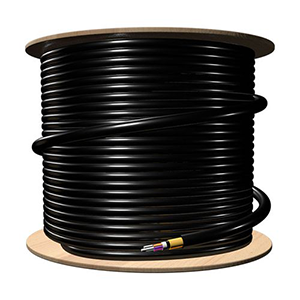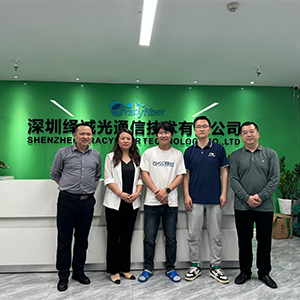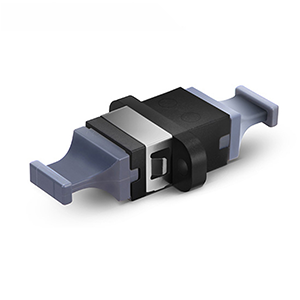Today, I will introduce to you the importance of ADSS optical cable as an overhead optical fiber communication solution. We will explore the principles, characteristics and application areas of ADSS optical cables. As an innovative technology, ADSS optical cable has great potential and advantages in overhead communications. Let us learn more about ADSS optical cables together!
Basic knowledge of ADSS optical cable
ADSS (All-Dielectric Self-Supporting) optical cable is a special type of optical cable with a specific structure and working principle. The following is the basic knowledge of ADSS optical cable:
Definition and working principle: ADSS optical cable is an optical cable that does not contain metal reinforcements and uses an all-media structure to provide self-supporting capabilities. ADSS optical cable wraps a layer of insulating material around the optical fiber to give it sufficient mechanical strength and self-weight support capabilities. This allows ADSS optical cables to be hung directly on power transmission lines or communication towers without the need for additional brackets.
Structure and components: ADSS optical cable usually consists of the following main components:
- Optical fiber: ADSS optical cable contains one or more optical fibers for transmitting data and signals.
- Insulating material: A layer of insulating material is wrapped around the optical fiber, usually a non-metallic high-strength polymer, such as flame-retardant polyethylene (FRP) or flame-retardant polyamide (ARAMID).
- Outer sheath: There is a protective sheath on the outside of the optical cable, usually made of polyethylene (PE) or other weather-resistant materials, to protect the optical cable from damage from the external environment.
Transmission performance and technical indicators: The transmission performance and technical indicators of ADSS optical cable include:
- Transmission rate: ADSS optical cable can support different transmission rates, such as 1Gbps, 10Gbps, 40Gbps or higher, depending on the fiber type and equipment used.
- Transmission distance: The transmission distance of ADSS optical cable can be adjusted according to the type and quality of optical fiber. Common transmission distances can reach several kilometers to dozens of kilometers.
- Tensile strength: The insulation material of ADSS optical cable has sufficient mechanical strength and can withstand the tension of power transmission lines and external forces such as wind blowing.
- Fiber loss: The fiber loss of ADSS optical cable should be reduced as much as possible to ensure the transmission quality of optical signals.
- Environmental adaptability: ADSS optical cables need to have good weather resistance and UV resistance to adapt to various environmental conditions, such as high temperature, low temperature, humidity and UV radiation.
So ADSS optical cable adopts an all-dielectric structure to achieve self-supporting capability. Its structure includes optical fiber, insulation material and outer sheath. ADSS optical cable has certain transmission performance and technical indicators, including transmission rate, transmission distance, tensile strength, fiber loss and environmental adaptability.
What are the advantages of ADSS optical cable
ADSS (All-Dielectric Self-Supporting) optical cable has many advantages in overhead optical fiber communications. The following is a discussion of related content:
Overhead communication advantages: ADSS optical cable has the following advantages in overhead communication:
- Self-supporting ability: ADSS optical cable adopts an all-dielectric structure and has self-weight support capability. It can be directly hung on power transmission lines, communication towers or other supporting structures without the need for additional support rods or steel cables, reducing the cost of construction and maintenance. cost.
- Lightweight: ADSS optical cable uses non-metallic reinforcements, such as polymer insulation materials, so it is lighter and easier to hang and install than traditional metal-reinforced optical cables (OPGW).
- High bandwidth: ADSS optical cable can support high-speed data transmission, provide larger bandwidth capacity, and adapt to the growing communication needs.
Lightweight and high-strength properties: The lightweight and high-strength properties of ADSS optical cables bring the following advantages:
- Load reduction: Due to its lightweight characteristics, ADSS optical cable will not impose excessive load on the support structure, reducing the requirements for the support structure and reducing the difficulty and cost of erection.
- Tensile strength: ADSS optical cable uses high-strength polymer insulation material, which has good mechanical strength and can withstand the tension of power transmission lines and external wind forces, ensuring the stability and reliability of the optical cable.
Wind resistance, anti-electromagnetic interference and other advantages: ADSS optical cable has the following advantages in wind resistance, anti-electromagnetic interference and other aspects:
- Wind resistance: The self-weight support design of the ADSS optical cable enables it to withstand wind forces in high wind areas, reducing the swing and vibration of the optical cable and ensuring the stability and transmission performance of the optical cable.
- Anti-electromagnetic interference: ADSS optical cable adopts an all-dielectric structure and does not contain metal materials, so it is not affected by electromagnetic interference. It can stably transmit optical signals in an environment close to power transmission lines, reducing the communication quality that is affected by external electromagnetic interference. possibility.
So ADSS optical cable has the advantages of self-supporting ability, lightweight and high strength characteristics in overhead optical fiber communication. It can reduce load requirements, provide high bandwidth, resist wind and electromagnetic interference, and ensure the stability and reliability of communication systems.
Overview of ADSS optical cable application scenarios
ADSS (All-Dielectric Self-Supporting) optical cables are widely used in different environments and scenarios. The following are some application cases to illustrate their uses:
Power transmission lines: ADSS optical cables play an important role in power transmission lines and are used to monitor, communicate and control the power system. It can be suspended along transmission lines to transmit power system data and monitoring information, providing real-time monitoring, fault detection and maintenance support.
Railway communications: ADSS optical cables are widely used in railway communications. It can be hung along railway lines to provide high-speed data transmission and communication support for train operation control, signaling systems, communication networks and video surveillance.
Road communications: ADSS optical cables are also widely used in the field of road communications. It can be hung along the highway to provide reliable communication and data transmission for intelligent transportation systems, highway monitoring, street light control, emergency call systems, etc.
Urban communication network: In urban environments, ADSS optical cables can be used to establish urban communication networks, connecting different buildings, offices, data centers and communication base stations, etc., supporting Internet access, telephone communications, video surveillance and Internet of Things applications, etc.
Environmentally sensitive areas: The application of ADSS optical cables in environmentally sensitive areas is also very important. Because it does not contain metal materials and will not interfere with electromagnetic sensitive equipment, it is suitable for places that need to resist electromagnetic interference, such as hospitals, laboratories, aerospace facilities, etc.
Specific application cases include:
- In power transmission lines, ADSS optical cables are used for monitoring and communication to realize the construction and operation management of smart grids.
- In railway communications, ADSS optical cables are used in signaling systems, train control and communication networks to ensure the safety and efficiency of railway operations.
- In highway communications, ADSS optical cables are used in intelligent transportation systems and street light control to provide real-time data transmission and remote monitoring.
- In urban communication networks, ADSS optical cables are used to connect office buildings, data centers and communication base stations to support fast Internet access and communication services.
How to install and maintain ADSS optical cable
The installation and maintenance of ADSS (All-Dielectric Self-Supporting) optical cables are key aspects to ensure their performance and reliability. The following is a discussion of related content:
Key steps and key points for ADSS optical cable installation:
- Planning and design: Before installing the ADSS optical cable, sufficient planning and design are required, including determining the path, support structure, tension requirements, etc. of the optical cable.
- Material preparation: Prepare the required ADSS optical cables, connectors, hanging gear and other materials, and conduct inspection and testing to ensure that they meet specifications and requirements.
- Line preparation: Clean and inspect the lines to ensure the stability and adaptability of the supporting structure.
- Optical cable hanging: Use appropriate hanging gear to hang the ADSS optical cable on the supporting structure, paying attention to maintaining appropriate tension and verticality.
- Connection and terminal processing: Perform optical cable connection and terminal processing as needed to ensure connection quality and signal transmission reliability.
- Testing and acceptance: Carry out necessary testing and acceptance procedures, including inspection of the optical performance, electrical performance and mechanical performance of the optical cable.
ADSS cable installation and tension control technology:
- Hanging technology: The hanging of ADSS optical cables should maintain appropriate tension and verticality to ensure the stability and transmission performance of the optical cable during operation. Use appropriate hanging gear and tension control devices to hang according to design requirements and avoid excessive tension or excessive bending.
- Tension control technology: Tension control of ADSS optical cable is crucial to the performance of the optical cable. Proper tension control can avoid excessive tension or relaxation of optical cables under wind or temperature changes, and reduce the vibration of optical cables and the load on the supporting structure. Commonly used tension control technologies include tension rings, tension devices and buffer devices.
The importance of regular inspection and maintenance of ADSS optical cables:
- Regular Inspections: It is very important to regularly check the status and performance of ADSS optical cables. Inspections include visual inspection, connection point inspection, tension inspection, etc., as well as transmission performance and loss testing of optical cables. If potential problems are discovered early, timely measures can be taken to repair them and ensure the reliability of the communication system.
- Maintenance measures: In addition to regular inspections, some maintenance measures should also be taken to extend the life and performance of ADSS optical cables. This includes protective measures such as bird protection, wind protection and anti-corrosion measures, as well as regular cleaning and maintenance of the environment for fiber optic cables.
So the installation and maintenance of ADSS optical cables need to follow key steps and points, including planning and design, material preparation, hanging and connection processing, etc. At the same time, the correct application of hanging and tension control technology can ensure the stability and transmission performance of the optical cable. Regular inspection and maintenance are very important to detect problems and take appropriate measures to ensure the reliability and durability of ADSS optical cables.
Overview of ADSS optical cable development trends
ADSS (All-Dielectric Self-Supporting) optical cable is a key communication infrastructure technology. With the development of science and technology, it is constantly evolving and improving. The following are some trends about the future development of ADSS optical cables:
Increase bandwidth and transmission speed: As the Internet and big data applications continue to grow, the demand for bandwidth and transmission speed is also increasing. Future ADSS optical cable technology will strive to provide higher bandwidth capacity and faster transmission speeds to meet the growing data demand.
High-density optical fiber technology: High-density optical fiber technology is an important development direction in the field of ADSS optical cables. By adopting higher-density optical fiber layout and more compact optical cable structure, greater transmission capacity and higher density can be achieved, and the efficiency and performance of optical fiber cables can be improved.
Intelligent monitoring and management: Intelligent monitoring technology also has an important impact on the development of ADSS optical cables. By integrating sensors and monitoring equipment into optical cables, real-time monitoring and fault location of optical cables can be achieved, improving maintenance and management efficiency. Intelligent monitoring can also help predict potential failures and optimize fiber optic cable performance.
High reliability and environmental adaptability: Future ADSS optical cables will pay more attention to high reliability and environmental adaptability. The material and structural design of optical cables will be more durable and anti-interference to adapt to various complex environmental conditions. In addition, the laying and installation of optical cables will be more convenient and flexible to adapt to different scenarios and application needs.
Expanded application fields: ADSS optical cables will be used in more fields. In addition to the traditional fields of power, railway and highway communications, it will also expand to emerging fields such as smart cities, Internet of Things, 5G communications and high-speed transmission. The reliability, high bandwidth and adaptability of ADSS optical cables make it an important infrastructure for the future digital society.
With regard to the outlook and forecast for future applications and markets of ADSS optical cables, it can be expected that its market size will continue to grow. As digital transformation advances and emerging technologies develop, the demand for high-speed, reliable and high-density communications will further increase. As a high-performance communication solution, ADSS optical cable will play an important role in various fields and provide basic support for the construction and development of future communication networks.
Summary
Thank you for reading our blog! Through the discussion in this article, you will have a deeper understanding of the importance of ADSS optical cable as an overhead optical fiber communication solution. ADSS optical cable has become an ideal choice for overhead communications due to its lightweight, high strength, wind resistance, and electromagnetic interference resistance..
ADSS optical cable technology is constantly developing and has broad prospects in the future. Emerging technologies such as high-density optical fiber and intelligent monitoring will have a profound impact on ADSS optical cables. We are confident in the future applications and market prospects of ADSS optical cables, and look forward to providing you with more advanced and efficient solutions.
ADSS Cable FAQ
ADSS cables differ from other fiber optic cables in that they are designed to bear their own weight without the need for additional support. This makes them suitable for aerial installations, such as along power lines or railway tracks.
The main advantage of using ADSS cables is that they can be installed on existing infrastructure, such as power distribution poles or transmission towers, without the need for additional support structures. This can help reduce installation costs and deployment time.
ADSS cables are commonly used in various applications, including telecommunications networks, power utility networks, railway communications, and broadband internet access in rural areas. They are suitable for long-span installations and environments with high electrical interference.
Yes, ADSS cables are designed to withstand high-voltage environments. They are typically installed above power lines and can withstand electrical currents without any impact on their performance.
An ADSS cable consists of several components, including optical fibers for transmitting data, a central strength member for mechanical support, water-blocking materials for moisture protection, and an outer sheath for environmental protection.
The maximum span length of an ADSS cable depends on various factors, including cable design, fiber count, and environmental conditions. Span lengths can range from a few hundred meters to several kilometers.
Yes, ADSS cables are designed to withstand harsh weather conditions, including high winds, ice, and extreme temperatures. They are built with materials that provide resistance to environmental factors, ensuring reliable performance.
ADSS cables can be spliced and terminated like other fiber optic cables. Fusion splicing or mechanical splicing methods can be used to join fiber optic cables together, and standard fiber optic connectors can be used for termination.
While ADSS cables are primarily designed for aerial installations, they can also be used in urban environments. However, the availability of suitable support structures and the presence of other underground utilities may influence the feasibility of using ADSS cables in urban areas.





